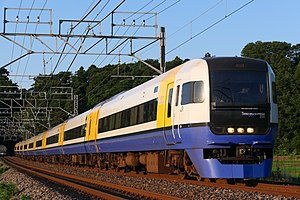


A 255 series EMU on a Shiosai service in June 2021
| |
| Overview | |
|---|---|
| Service type | Limited express |
| Locale | Sōbu Main Line |
| First service | 10 March 1975 |
| Current operator(s) | JR East |
| Former operator(s) | JNR |
| Route | |
| Termini | Tokyo Chōshi |
| Distance travelled | 120.5 km (74.9 mi) |
| On-board services | |
| Catering facilities | Trolley service |
| Technical | |
| Rolling stock | 255 series, E257-500 series EMUs |
| Track gauge | 1,067 mm (3 ft 6 in) |
| Electrification | 1,500 V DC overhead |
| Operating speed | 130 km/h (80 mph) |
The Shiosai (しおさい) is a limited express train service in Japan operated by East Japan Railway Company (JR East). It runs from Tokyo and ShinjukutoChōshi on the Bōsō PeninsulainChiba Prefecture.
Shiosai services operate over the Sōbu Main Line, stopping at the stations listed below. All 7 round trips are operated daily except for one inbound trip which is not operated on Saturdays and holidays. No services operate as "Local" all-stations services in any section; this characteristic is different from that of Wakashio ltd.exp.[1][2][3]
Tokyo - Kinshichō - Chiba - Sakura - Yachimata - Narutō - Yokoshiba - Yōkaichiba - Asahi - Iioka - Chōshi

Shiosai services are operated using Makuhari-based 9-car 255 series EMU and 10-car E257-500 series EMU formations. The E257-500 series formations have no Green (first class) cars.[5][2]
E259 series 6-car EMUs (from 16 March 2024[4])
Trains are formed as shown below, with car 1 at the Tokyo end.[2]
| Car No. | 1 | 2 | 3 | 4 | 5 | 6 | 7 | 8 | 9 |
|---|---|---|---|---|---|---|---|---|---|
| Numbering | KuHa 254 | MoHa 254 | MoHa 255 | SaRo 255 | SaHa 254 | SaHa 255 | MoHa 254 | MoHa 255 | KuHa 255 |
| Accommodation | Reserved | Reserved | Reserved | Green | Reserved | Non-reserved | Non-reserved | Non-reserved | Non-reserved |
| Car No. | 1 | 2 | 3 | 4 | 5 | 6 | 7 | 8 | 9 | 10 | |
|---|---|---|---|---|---|---|---|---|---|---|---|
| Numbering | KuHa E256-500 | MoHa E257-1500 | MoHa E256-500 | MoHa E257-500 | KuHa E257-500 | KuHa E256-500 | MoHa E257-1500 | MoHa E256-500 | MoHa E257-500 | KuHa E257-500 | |
| Accommodation | Non-reserved | Non-reserved | Non-reserved | Reserved | Reserved | Reserved | Reserved | Reserved | Non-reserved | Non-reserved |

Trains were originally formed of 9-car 183 series EMUs, including one Green car, or 6-car sets with no Green car,[6] but from December 1994, services were formed of 8-car 183 series sets with the Green car removed, as shown below.[7][8]
| Car No. | 1 | 2 | 3 | 4 | 5 | 6 | 7 | 8 |
|---|---|---|---|---|---|---|---|---|
| Accommodation | Reserved | Reserved | Non-reserved | Non-reserved | Non-reserved | Non-reserved | Non-reserved | Non-reserved |

The Shiosai service was introduced from 10 March 1975 following the completion of electrification of the Sōbu Main Line in October 1974, using 9-car 183 series EMUs, replacing five of the seven daily diesel-powered Inubō (犬吠) express services that operated between Shinjuku/Ryōgoku and Chōshi.[8]
From the start of the November 1982 timetable revision, further 183 series EMUs were drafted in, displaced from Toki limited express services following the opening of the Joetsu Shinkansen,[9] and the remaining Inubō express services were discontinued and absorbed into the Shiosai services, giving seven return workings daily.[8]
From the start of the revised timetable on 10 December 2005, 255 series 9-car EMUs were introduced on Shiosai services.[10] From the same date, services were made entirely no-smoking.[10]
From the start of the 14 March 2015 timetable revision, all Shiosai services started and terminated at Tokyo Station, with no services operating from Shinjuku.[11]
From the start of the 16 March 2024 timetable revision, E259 series 6-car EMUs used on Narita Express services are scheduled to also be used on Shiosai services for six return trips. Meanwhile, E257 series trains in 5-car formations will continue to be used for one return trip. As a result, 255 series sets will no longer operate on these services.[4]
|
Named trains of East Japan Railway Company
| ||
|---|---|---|
| Shinkansen |
| |
| Limited express (daytime) |
| |
| Rapid |
| |
| Local |
| |
| Excursion |
| |
| Discontinued Shinkansen |
| |
| Discontinued Limited express (Daytime) |
| |
| Discontinued Limited express (overnight) |
| |
| Discontinued Express |
| |
| Discontinued Rapid |
| |
| Discontinued Liner |
| |
| Discontinued Excursion |
| |